A tornado ... except worse: Israeli military took me to Gaza. It was post-apocalyptic.
The rain came down hard the morning I was due to go into Gaza, moving in off the Mediterranean as it usually does, and perhaps it was just as well. They say it’s often too cold or hot or wet in a war, so maybe this was the way to see it.
But by the time we dozen journalists gather at 10 a.m. by a deployment spot just outside the strip, the storm is over, the sky leaden, the air cool enough that you are glad for the extra layer of the required bulletproof vests.
It is the first time the Israel Defense Forces has taken reporters inside in three or so weeks. Among our stops will be a tunnel destroyed the night before. It ran from the nearby Khan Yunis refugee camp, where fighting is now heavy, under the no man’s land buffer near the border fence, ending so close it took just minutes for scores of Hamas to charge into Israel on that terrible day of Oct. 7. That’s the only thing the tunnel was for.
Our assigned overseer is IDF Lt. Col. Anshi, first names only, a courteous tech guy in civilian life who, like countless Israelis, has been called to war.
Among those gathered for the embed are correspondents with CBS and Fox News, as well as counterparts from other countries. Anshi asks us to turn off our phone locations – no one wants a surprise.
'Welcome to Gaza'
We squeeze into a pair of side-bench Humvees, then start speeding along the border on our left, splashing through puddles and sandy mud. On our right are bountiful banana plants belonging to a nearby kibbutz where dozens were slaughtered, and each time soldiers go by it, they are reminded of why they are here.
Every few seconds, military vehicles speed past us the other way, going out. Israeli combat soldiers don’t like to drive slowly. Our Humvee has a canvas top, open sides and a front-mounted machine gun. It lurches as we go, wind whipping loudly around us.
Suddenly, we turn left through a break in the fence.
Lt. Col. Anshi would soon tell us it’s one of the very openings blown apart by Hamas on their way in. You can’t help but note the irony that Israel is now using it to attack back.
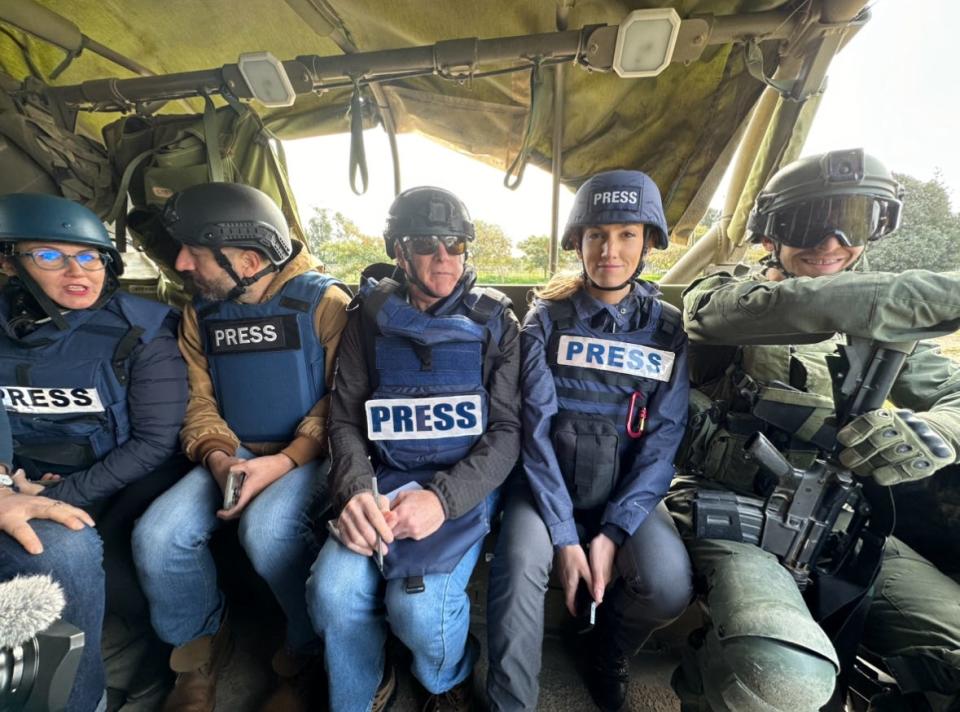
The Gaza side is open terrain, weedy and treeless, left fallow as a clear zone. Soon, we pull up to a spot with big piles of dirt, excavated to reveal the tunnel below.
“Welcome to Gaza,” says Anshi.
So far, because there are no buildings, I don’t see the familiar images of dystopia. But Anshi says we’ll get there.
At that, there’s an enormous boom – a helicopter-fired missile, he says. The front line, explains Anshi, is less than a mile away in dense Khan Yunis. An hour from now, I would hear a more unsettling sound of war.
Many US voters want Gaza cease-fire. Do Jewish, evangelical faithful agree?
There’s a steep dirt ramp to the tunnel opening, soldiers posted along it to help us down.
“We were surprised by the scope of it,” says Anshi. It runs all the way to Khan Yunis, then connects to the Gaza “subway.”
Two at a time, we walk and slide down to see it, boots sinking into the deep loose earth. When I get to the bottom, a burly soldier named Major Nir is next to it.
“It’s so close to the border,” I say.
Major Nir shakes his head. “It’s not near the border,” he says, “it’s on the border.”
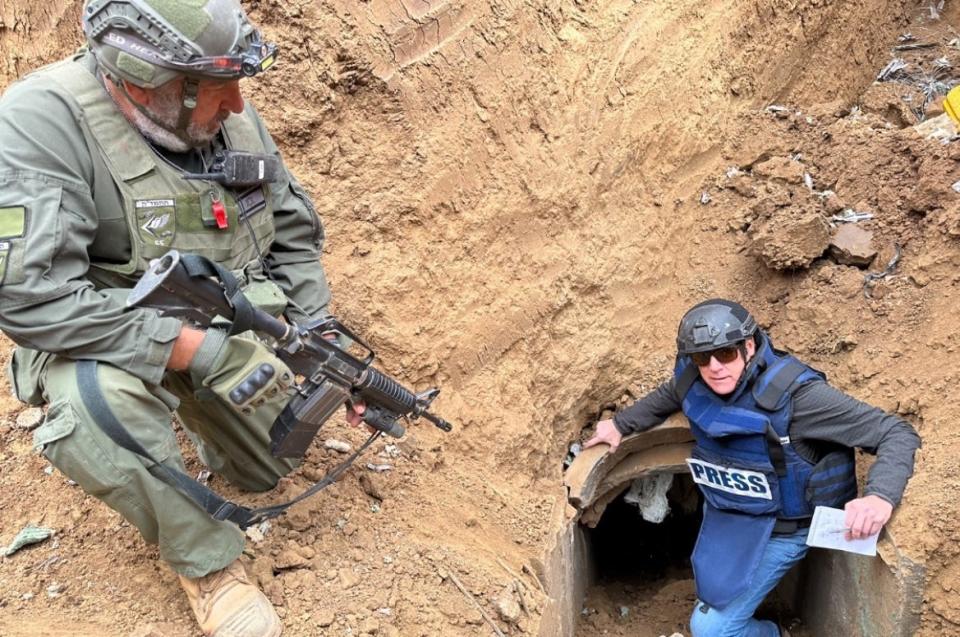
Everyone in Israel has an Oct. 7 story
Nir’s five-day beard growth is white. It turns out he’s 66 and a businessman but volunteered to do his part. His son is at Khan Yunis in the fight. It worries Nir, but this is where both feel they need to be.
I slide past Nir down the last 8 feet to look directly into the opening. The top is reinforced with curved concrete, and I can’t help but think, here it is – one of the spots where it began, a war that has upended the world.
As other pairs of journalists go down, I head to ground level and chat with Anshi. I’ve learned by now that almost everyone in Israel has an Oct. 7 story. In Anshi’s case, he was awakened by missiles that morning, and within a day, was deployed with the job of collecting civilian bodies.
Hamas still holds my son hostage. Every day has been a living nightmare.
Anshi has two kids, 19 and 15. He spent a few of his younger years in Boston when his physician dad worked at Dana-Farber.
That’s when I hear the sound that’s more unsettling than explosions, though not as loud. It’s automatic weapons fire, closer than I expected. It goes nonstop for many minutes and makes you picture what that kind of fighting must be like.
“It’s a skirmish,” says Anshi. “There’s no big armor-versus-armor. It’s two terrorists coming out of a hole and shooting.”
“How close?” I ask.
“Twenty to 30 meters,” he says. “Or less. Everything is close.”
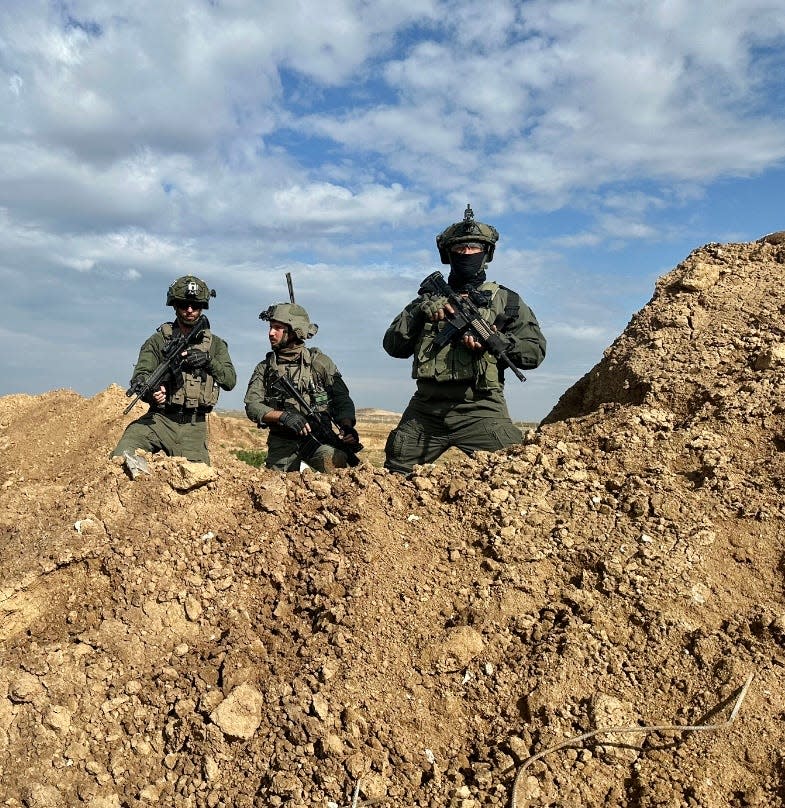
Entering dystopia
Indeed, most soldiers carry rifles with shortened stocks so they can swing the weapons around corners without being overly exposed. That is how the ground war here is being fought.
Early in it, Anshi says, too many Israelis were killed because of mistakes. When a Gaza civilian called for help, or a Hamas member darted away, IDF troops would run toward them. But it was usually a trap.
“We paid a heavy price for that,” Anshi says. “There was a lot of learning.”
And it’s still a dilemma, with unarmed “civilians” walking innocently, then running into a house where they’ve stashed weapons.
We squeeze back into the Humvees, speeding to our next stop, an elementary school Hamas used as a base.
“Every school,” says Anshi. “Every mosque. Every health facility.”
As we head that way, the terrain changes and we reporters fall silent.
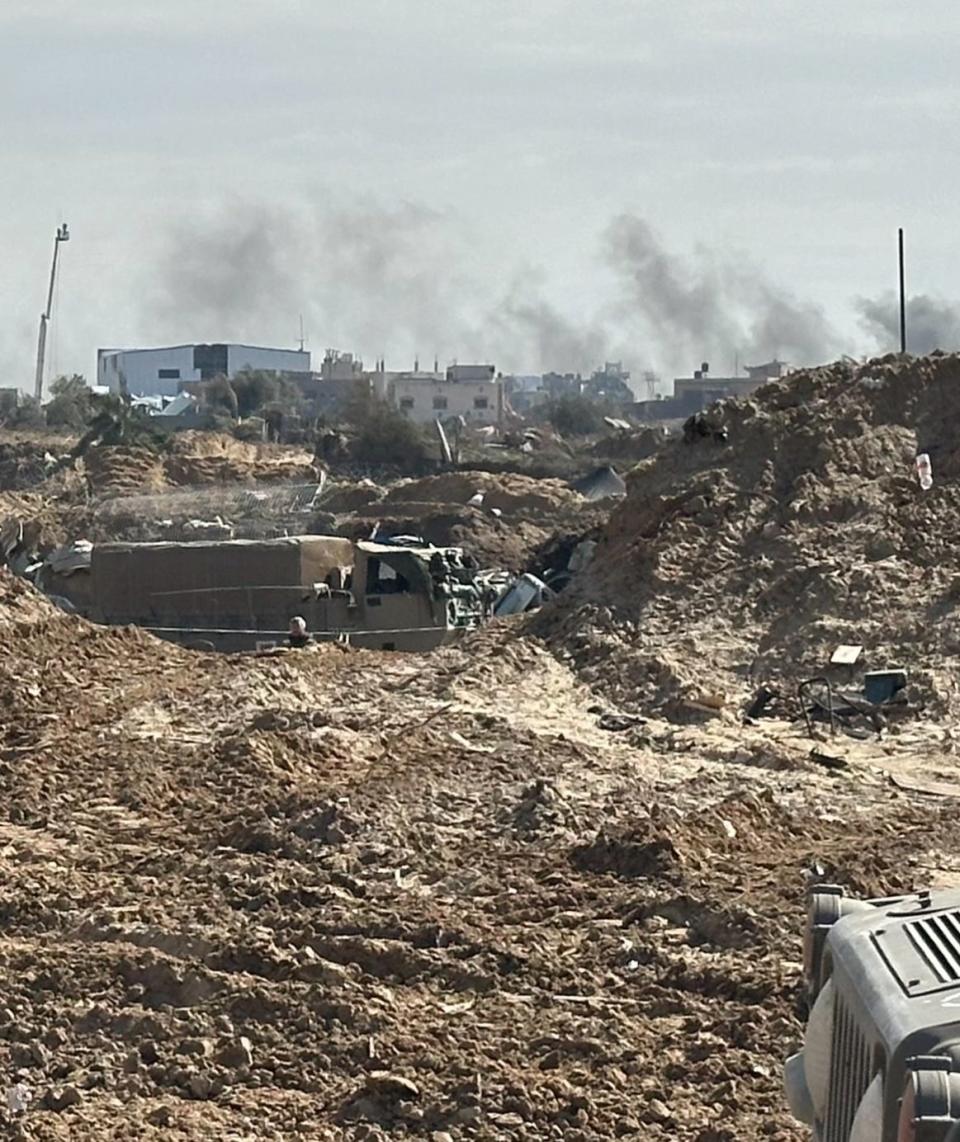
We’ve entered dystopia, a suburb where big stone homes with a half-acre or so around each unfold in a mile-long, treeless neighborhood as we drive.
Except now it’s post-apocalyptic, most of the houses turned to rubble piles. It’s like a tornado scene, except worse because the earth is disrupted, too.
At last, we pull up to a large elementary school, three stories high with two wings. It has become an IDF staging area with many soldiers and parked tanks.
Anshi says they took the school from militants at night, then secured it, or thought they did. The next morning, four Hamas came out of a missed basement tunnel and began firing. Two of Anshi’s men were killed in seconds. So were three Hamas, the fourth escaping back down the tunnel.
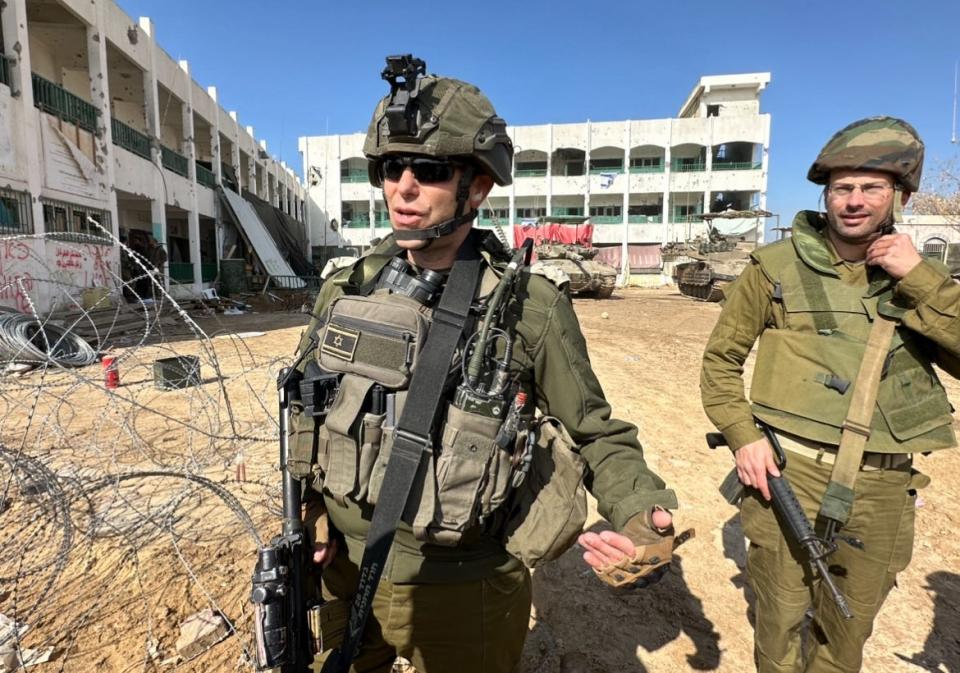
Moments after that battle, as Anshi walked by a school door, a sniper bullet went through the flesh of his left arm.
That’s the kind of war it is, he says. They come out of both the ground and nowhere.
How can this place ever be whole again?
It’s the reason most houses we just drove through were destroyed. That stays with me as a terrible sight, a beautiful neighborhood demolished. But Israeli soldiers ask, what do you do when militants hide in it to kill you?
I approach another soldier who is trying to light a cigarette, but the wind is too strong. He tries three times before he gets it. He gives his name as Bar, 26, and says he was on vacation in Thailand on Oct. 7.
He was back on Oct. 8, assigned to help tow the burned cars at the Nova music festival site, some no doubt with human remains, to a gathering point. Bodies of Hamas militants were still on the ground.
Is Israel guilty of genocide in Gaza? Why the accusation at the UN is unfounded.
Bar’s grandparents used to tell him about Jews being murdered in pogroms in Russia, which seemed far in the past. But now it had happened again, and that, he says, is why he fights, so Israel can be safe.
At that, there is a blast so huge things around us shake. A soldier says it was a bomb from an Israeli plane. We are 2 miles into Gaza, close enough to the war that 20 seconds later the bomb’s diffuse smoke wafts across us with a fireworks smell.
Opinion alerts: Get columns from your favorite columnists + expert analysis on top issues, delivered straight to your device through the USA TODAY app. Don't have the app? Download it for free from your app store.
Anshi says it’s time to go – embed trips like this are tightly scripted – and soon we’re speeding back across the dystopian landscape. For every house left standing, there are five turned to debris.
It makes you wonder how this place can ever be whole again. And whether Israel needed to do this much damage. But you wonder more why Hamas doesn’t free the hostages and save what’s left of the land they call home.
Now our two Humvees turn through the hole in the border fence, leaving Gaza behind, and a mile later, arrive at our original staging area. They tell us the information from the trip is embargoed for 24 hours because it could put troops in jeopardy.
The clouds have receded, and as my guide and I begin the drive back to Jerusalem, I see a contrast that to me is a symbol of Israel.
It’s a beautiful grove that goes on and on, the sun reflecting off thousands of Jaffa oranges. So much promise.
But so close to the border.
And the sounds of war that follow us as we drive.
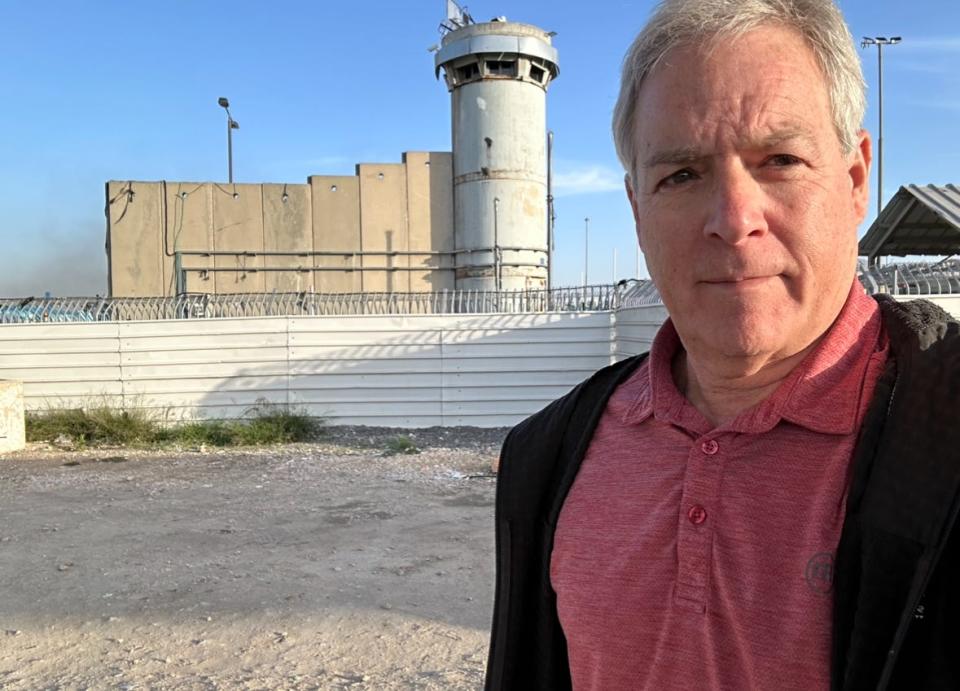
Photos of Mark Patinkin by Robby Berman, hired by Mark as translator and journalist's guide for this story. Mark Patinkin is traveling to Israel personally and is not sponsored by or affiliated with any organization. He will report firsthand from the region as he has done for the last four decades through his award-winning journalism. This column first published in The Providence Journal. He can be reached at [email protected]
You can read diverse opinions from our Board of Contributors and other writers on the Opinion front page, on Twitter @usatodayopinion and in our daily Opinion newsletter.
This article originally appeared on The Providence Journal: Israel military took me through Gaza. What I saw was post-apocalyptic
